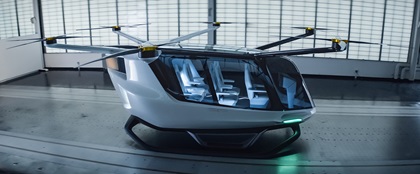Hydrogen propulsion shows promise
Examples of the coming generation of vertical-lift aircraft made for urban mobility were center stage in the Innovation Showcase at EAA AirVenture in Oshkosh, Wisconsin. Not settled there, though, was the debate about how to power them.

While the vision of whisking passengers between rooftops in aircraft capable of vertical takeoff has largely solidified in the general shape of multiple rotors, some with airfoils and others without, the question of how to power this new kind of aircraft is less so. Some envision pure electric with lots of high-capacity batteries; others believe batteries alone will never be ready to produce the power required, and pitch hybrid designs—with a fossil-fueled engine producing electricity to assist the motors during some or all phases of flight.
A tank of liquid hydrogen in the aircraft could propel it up to about 100 knots for up to 400 miles or four hours, carrying up to 1,000 pounds, according to Bruce Holmes, Ph.D., a director at Alakai. The electricity is produced via a hydrogen fuel cell—similar to the technology used to propel spacecraft like the Apollo ships that took the first men to the moon back in 1969.
A fuel cell is relatively simple: A fan propels gaseous hydrogen from the top of the liquid tank and mixes the elemental gas with ambient air through the fuel cell. The hydrogen passes through a platinum screen and in doing so loses an electron and produces electricity. The only emissions are water and heat. Holmes said because the hydrogen boils in typical ambient conditions, about 1 percent per day is lost—even with the best tankage technology available.
The resulting heat can be used for warming the vehicle. The cold liquid hydrogen can be used for cooling the cabin and is pumped beneath the six motors to help cool them.

Skai will use fuel cells from Hydrogenics, which is being acquired by a subsidiary of diesel-engine manufacturer Cummins.
The liquid hydrogen is stored on the aircraft at about 150 psi. Fueling infrastructure is not in place at airports, yet. However, Holmes envisions it being much like hydrogen fueling stations for cars cropping up in California and five other states as well as nine other countries, all of which are participating in a coordinated international effort to expand the use of hydrogen-powered electric propulsion. Refueling times will be as little as 10 minutes.
In addition to the six redundant rotor systems, Skai is slated to include an airframe parachute and will be designed to be piloted from the ground, piloted from the aircraft, and capable of autonomous operation. The company is proposing an aggressive certification plan that calls for a type certificate, perhaps as soon as the fourth quarter of 2020. Holmes expects military versions will be flying soon, and that experience, he believes, will help the FAA get comfortable with the vehicle’s simple design features—especially since, other than the rotors, about the only moving part is the fan in the fuel cell. Three conforming prototypes will be built for the certification process.
With hydrogen sourced through renewable resources such as hydropower, wind, and solar, and with the fuel cell 95 percent reusable and 99 percent recyclable, Holmes said the aircraft will be much more environmentally friendly than aircraft using batteries or fossil fuels. A fuel cell has a 20,000-hour life-cycle, he said.



